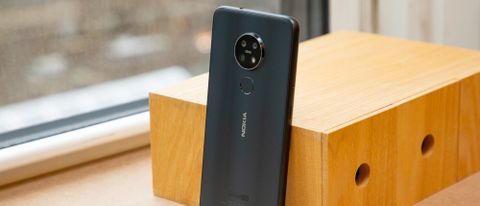Tom's Guide Verdict
The Nokia 7.2 is a decent smartphone for under $350, but the Pixel 3a, Galaxy A50 and Moto G7 surpass it in performance and value.
Pros
- +
Excellent build quality
- +
Bright display
- +
Pure Android One software
Cons
- -
Tinny speakers
- -
Underwhelming cameras
- -
Average battery life
- -
Outdated Android 9 software
- -
Only compatible with GSM carriers
Why you can trust Tom's Guide
The Nokia 7.1 was one of late 2018's best cheap smartphones for several reasons. It had a distinctive design composed of quality materials that you wouldn't expect from a $349 handset, an impressive HDR-capable LCD display, solid cameras, a refreshing software experience and good-enough performance.
If you were eyeing something more premium than a Moto G6 but didn't quite have enough to spend on a OnePlus 6, the Nokia 7.1 was the easy choice. Now, HMD Global, which sells phones under the Nokia brand, has finally rolled out a successor: the aptly titled, identically priced Nokia 7.2, that mostly picks up where its predecessor left off — for better and worse.
Sure, the Nokia 7.2 is better in lots of little ways, but the midrange smartphone market isn't the same as it was a year ago. Today, the Finnish brand has Google's Pixel 3a and its flagship-class camera to contend with, as well as Samsung's bold reentry into the segment with the well-rounded Galaxy A50. And although the Nokia 7.2 is once again compelling enough to land on our list of the finest budget handsets, in that company, it struggles to rise to the level of the best Android phones overall.
Nokia 7.2 specs
| Price | $349 |
| Display (resolution) | 6.3-inch LCD (2280 x 1080) |
| Rear cameras | Triple: 48-MP primary (ƒ/1.8); 8-MP ultrawide (ƒ/2.2); 5-MP depth (ƒ/2.4) |
| Front camera | 20 MP (ƒ/2.0) |
| CPU | Qualcomm Snapdragon 660 |
| RAM | 4GB |
| Storage | 128GB |
| microSD slot? | Yes; up to 512GB |
| Battery | 3,500 mAh |
| Battery life | 8:20 |
| Size | 6.30 x 2.96 x 0.33 inches |
| Weight | 6.35 ounces |
Nokia 7.2 design: Well-built but boring
I'm of two minds about the Nokia 7.2 from a design perspective. On the one hand, its rounded corners, teardrop notch and circular rear triple-camera housing strike me as unimaginative when so many models from Motorola and OnePlus have already done that tired look to death. The Nokia 7.1 looked fresh, classy and unique, with its chamfered edges and gleaming metallic trim; the 7.2 looks completely forgettable by comparison.
And yet, I find myself once again so impressed by the way HMD has approached fit and finish with this device that I'm almost willing to cast aside my disappointment with the aesthetics.

The Nokia 7.2 comes in two colors. While the aquatic green is my favorite without a doubt, our charcoal review unit still cleans up nicely, thanks to its sleek, sophisticated satin-like matte glass.
Flip the 7.2 on its side and you'll find a rock-solid metal frame — or is it actually made of plastic? Surprisingly, Nokia says it's polycarbonate, but trust me: you'd never be able to tell. The chassis feels so robust, with zero give and no creaking, and the buttons are so tight and clicky, that I'd go so far as to say that Nokia's construction feels on a par with most flagships' leagues beyond the Galaxy A50's and even a bit nicer than the Pixel 3a's.
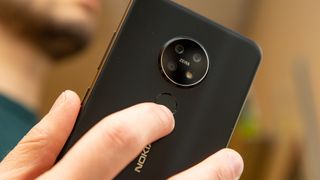
I also have to give Nokia kudos for the soft white LED strip embedded into the power button, that breathes to tell you when you've received a notification. A similarly-shaped, albeit non-lit key on the opposite edge of the device offers a quick shortcut to Google Assistant.
Along the top, you'll find a 3.5-millimeter headphone jack; not uncommon on budget handsets, though nevertheless appreciated. On the bottom, you'll find a lone speaker, and therein lies my only serious gripe with the Nokia 7.2's hardware. This tinny mono driver shrieks in the upper registers but retains absolutely no low end, such that if you play a bass-heavy track — like trance classic "Age of Love" — you won't hear anything except hissing, even at full volume. It's the only aspect of this phone where you get the sense Nokia cheaped out.
Nokia 7.2 display: Good (for LCD, anyway)
The 6.3-inch, full-HD display inside the Nokia 7.2 might be LCD rather than OLED, but the company is still promoting it as one of the device's standout features. That's because it's powered by Nokia's PureDisplay engine — meaning the 7.2 isn't only HDR-ready, but it can also simulate HDR's expanded color range on any SDR content.

Price: $349
Display (resolution): 6.3-inch LCD (2280 x 1080)
Rear cameras: Triple: 48-MP primary (ƒ/1.8); 8-MP ultrawide (ƒ/2.2); 5-MP depth (ƒ/2.4)
Front camera: 20 MP (ƒ/2.0)
CPU: Qualcomm Snapdragon 660
RAM: 4GB
Storage: 128GB
microSD slot?: Yes; up to 512GB
Battery: 3,500 mAh
Battery life: 8:20
Size: 6.30 x 2.96 x 0.33 inches
Weight: 6.35 ounces
With PureDisplay active, colors are more saturated, edges are sharper and contrast — the disparity in luminance between the brightest and darkest areas of a scene — is boosted. I won't say this necessarily makes for a better picture in all instances; for example, watching a trailer for the upcoming Sonic the Hedgehog movie on the 7.2 and Google's Pixel 3a, I felt PureDisplay played to the movie's cartoony color palette and frenetic, strobing electric visual effects. If you're watching something more rooted in reality, however, the heavy-handed postproduction isn't all that beneficial.
Still, PureDisplay cannot make up for the fact that this is, after all, just an LCD panel — so you're not getting OLED-quality inky blacks here. The color cast is generally cool, and even the darkest tones take on a slightly gray appearance, because the screen still needs to light those pixels even though they're showing no color. That's forgivable on a phone this cheap, though OLED panels are trickling down to progressively more affordable handsets these days — so Nokia might not be able to hold out for long.
At least the Nokia 7.2's 511 nits of peak brightness and 153% coverage of the sRGB color spectrum are solid marks for the category. The Pixel 3a tops out at 408 nits, which makes it difficult to see outside on a sunny day next to the Nokia. That said, the Pixel's more robust 182% color gamut demonstrates what OLED technology can do for bolder hues.
Nokia 7.2 camera: Quantity over quality
Nokia wants you to believe the triple-lens camera on the back of the 7.2, headlined by a 48-megapixel, ƒ/1.8 primary lens, can capture photos that rival some from leading flagships. With an 8-MP ultrawide lens and 5-MP depth sensor, Nokia aspired to make the 7.2 just as versatile as those pricier handsets, too.
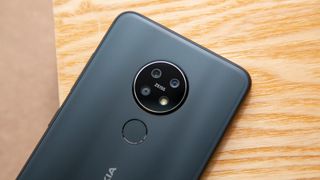
But if there's one thing we know about the finest mobile cameras, it's that hardware alone doesn't make for jaw-dropping photos; software is every bit as important. And software is where Nokia stumbles with the 7.2.
It's not for a lack of effort, though. Like some high-megapixel phone cameras, the Nokia 7.2's primary shooter employs a quad-Bayer filter on its 48-MP sensor that melds 4 megapixels into one for superior light sensitivity. Unfortunately, this evidently hasn't helped the device match the nuanced hues and just-right white balance of the Pixel 3a's post-processing.
This scene of a rustic building's worn facade carries so much more warmth and detail through the lens of Google's midrange offering, without any of the unrealistic oversharpening that plagues the 7.2's rendition.
Indoors, Nokia's difficulties managing intense sources of light are exacerbated. Notice how you can make out the filaments inside the light bulbs in the chandelier in the Pixel 3a's version of this cozy coffee shop scene; those same regions are totally blown out on the shot from the Nokia 7.2. Google's handset also more accurately renders the gray skies outside, though it loses points for the slight degree of noise it adds around the ceiling — blemishes Nokia’s device avoided.
The 7.2 can do something the Pixel 3a cannot, however — it can take ultrawide shots, using that 8-MP secondary lens. However, this is yet another case of reality falling short of specs. Although the photos captured with this lens do achieve the desired perspective, they’re also washed out and lacking detail, as a consequence of that rather low-resolution sensor.
Like the Pixel 3a, the 7.2 has a dedicated night mode, and can tune photo parameters based on what the camera sees — whether it's greenery or food, or if you're indoors or out. The night setting leaves the shutter open for an extended period to allow as much light to reach the sensor as possible, then takes a few seconds to process the result. But even with those tricks, the 7.2 fails to strike anywhere close to the Pixel's superior sharpness and coloring across the board. Nokia's best effort is a smudgy, awful mess.
That brings us to the 7.2's 20-MP front-facing camera. Here, I actually prefer the way Nokia's software diminished the shadows around my eyes and brightened my overall skin tone, though I wouldn't call the effect realistic. Beautification features were turned off on both handsets, but you wouldn't know it looking at the more muted, smoother portrait from the 7.2. Still, my philosophy surrounding front-facing cameras is that most people select the selfie thats more flattering, rather than the one that's truer to life, and the extra megapixels offered by Nokia's sensor at least make for a crisp result.
Nokia 7.2 performance: Fine, if you don't game
Inside the Nokia 7.2 is Qualcomm's Snapdragon 660 system-on-chip, which offers decent performance — so long as you're not doing a lot of gaming.
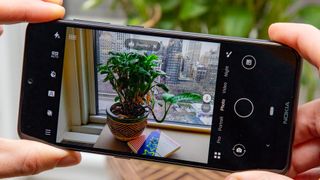
The Snapdragon 660 is an octa-core processor, and in that way it's similar to the Snapdragon 670 inside the Pixel 3a. The cores themselves are older, however they run at a higher clock speed than those inside the 670 — 2.2 GHz versus 2.0 GHz.
On the flip side, the 660 is built on an outdated, larger 14-nanometer process, which means it's less efficient than the 10nm silicon inside the Pixel 3a. The 660 also incorporates a lower-spec image-signal processor and GPU than the Pixel 3a, which may partially explain the gulf in photography quality and definitely explains the gaming deficit.

Overall, the Nokia 7.2 holds its own in everyday use and even eclipses the Pixel 3a in some raw benchmarks, like Geekbench 5. There, the Nokia's multicore score of 1,498 just managed to edge the Pixel 3a's 1,336 result — no doubt thanks to that quicker clock speed.
Unfortunately, 3DMark's Sling Shot graphics test presented another story entirely. There, the Nokia 7.2 fell well short of the Pixel 3a, posting a score of 2,054 points compared with Google's 2,543. That translated to occasional choppiness while playing PUBG Mobile, and I wouldn't push this phone with a title more demanding than that.
Nokia 7.2 battery: Nothing special
The Nokia 7.2's 3,500-mAh battery helped it along to just 8 hours and 20 minutes of runtime in Tom's Guide's custom battery test, where devices load a list of web pages indefinitely on T-Mobile's LTE network until their battery is drained.
That's 52 minutes less than the Nokia 4.2, which costs $189, and even further behind the Pixel 3a (11:29) and Motorola's epically long-lasting G7 Power (15:35), with its 5,000 mAh of power. The Nokia 7.2's battery life is serviceable for this class of phone, but it's nothing special. And because it's limited to Qualcomm's dated QuickCharge 3.0 technology, the battery doesn't top up quickly with the stock adapter, reaching only 38% from zero in a half hour in our testing.
Software: Yesterday's pure Android
Like the rest of Nokia's range, the 7.2 benefits from Android One software, making for a pure Google experience devoid of bloatware or any unwanted duplicate apps. Android One is just as smooth and delightful to use here as on other Nokia handsets, so I have no qualms about that aspect of the experience.
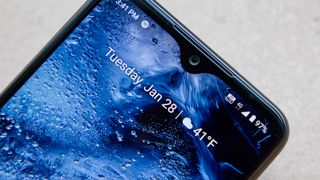
Rather, my complaints lie with the fact that the Nokia 7.2 comes with Android 9 Pie preinstalled — not Android 10, which has been available to the public since the fall in Google's own phones, and has already made its way to some devices from OnePlus and Samsung.
Part of the appeal of Android One, in theory, is that it's supposed to expedite updates, because the software is largely standardized by Google. That certainly hasn't played out in the case of the Nokia 7.2, even though, to the company’s credit, plenty of its other models — even 2018's Nokia 6.1 — have already received Android 10. While it's heartening to see HMD support older models, the fact that it hasn't played out for the 7.2 since its launch in October is unusual and frustrating.
Bottom line
The Nokia 7.2 isn't a bad phone by any means, and there are aspects of it — particularly the phone's quality design and bright, HDR-compatible display — that are compelling at the $350 price.
However, when you can have the Pixel 3a, and its astonishingly good camera, OLED screen, longer battery life, more powerful chipset and better software support for only an extra $50, the case for the Nokia 7.2 becomes much harder to make.
There's also Samsung's Galaxy A50 to consider, which costs the same as the 7.2 but boasts the finest screen in the midrange segment, as well as a triple-lens shooter that's still not quite at the level of Google's optics, but better than Nokia's. Or, if you really want to save every dollar you can, you may as well choose the $299 Moto G7 instead for battery life that outshines the 7.2's, and compatibility with all carriers.
There's nothing egregiously wrong with the Nokia 7.2; the problem is, better phones exist.
Adam Ismail is a staff writer at Jalopnik and previously worked on Tom's Guide covering smartphones, car tech and gaming. His love for all things mobile began with the original Motorola Droid; since then he’s owned a variety of Android and iOS-powered handsets, refusing to stay loyal to one platform. His work has also appeared on Digital Trends and GTPlanet. When he’s not fiddling with the latest devices, he’s at an indie pop show, recording a podcast or playing Sega Dreamcast.
